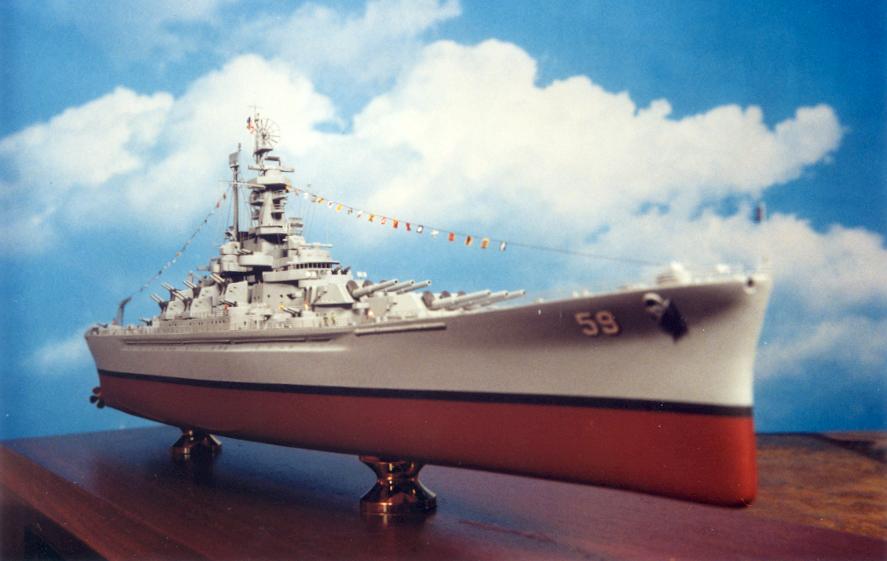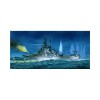You are viewing the archived version of the site.
Go to modelshipwrights.com for the current dynamic site!
Go to modelshipwrights.com for the current dynamic site!
1⁄720The USS Massachusetts BB-59
4
Comments
Revell 1/720 USS Massachusetts
KIT#: originally H-485, reissued by Revell Germany as kit 05031
PRICE: less than a dollar in 1968, about $10.00 now
REVIEWER: Tim Reynaga
NOTES: 1968 kit, currently issued by Revell Germany
HISTORY
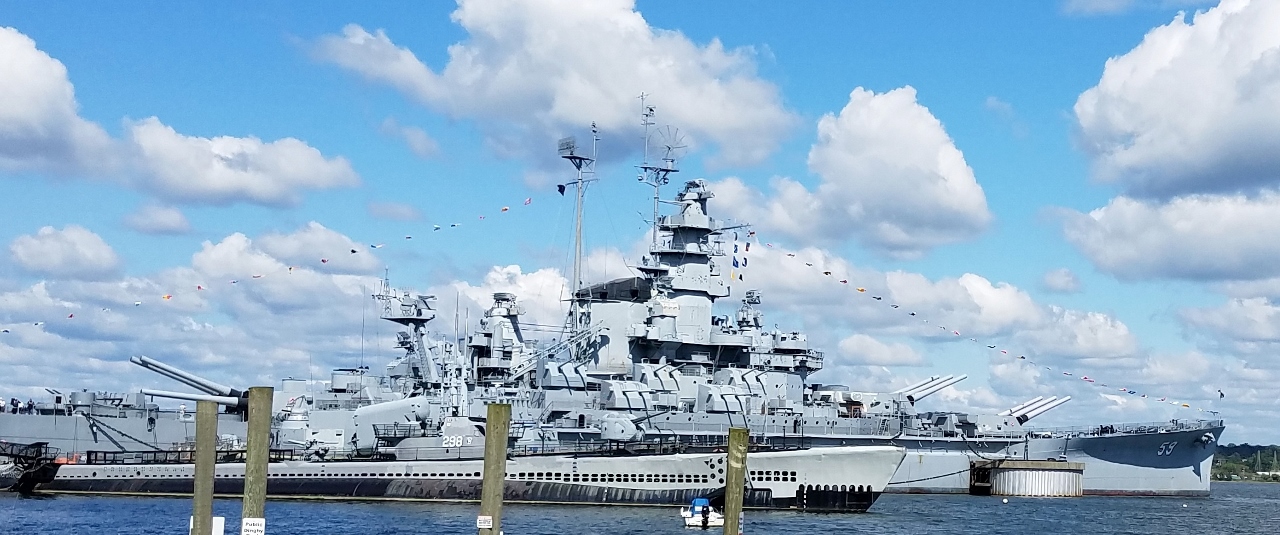
The USS Massachusetts (BB-59) was the third of four South Dakota class fast battleships built by the United States Navy in the late 1930s. Designed under the strict constraints of the 1922 Washington Naval Treaty (which was, unbeknownst to the USN, by then being ignored by Germany and Japan), they were smaller than the preceding North Carolina class. Nevertheless, they had the same main battery of nine 16 inch guns (which could hurl a 2,700 pound shell over 20 miles) as well as an imposing secondary battery of twenty 5 inch guns. They were also better protected than the North Carolina class with innovative sloped armor, better underwater protection, and were equipped with more modern machinery. The South Dakota class were the best of the "treaty battleships" built.
The Massachusetts (“Big Mamie” to her crew) was laid down in July 1939 at Bethlehem Steel in Quincy, Massachusetts, launched September 1941, and commissioned in May 1942. After shakedown, the ship left in October 1942 to participate in the Allied invasion of North Africa as flagship of the Western Naval Task Force. On 7 November the Massachusetts sailed into Casablanca harbor to confront a Vichy French naval squadron which included the battleship Jean Bart. It was a strange situation; although this was clearly an invasion of sovereign French territory, the Allies believed that Nazi Germany’s ambivalent allies would not fire upon Americans. The ships approached quietly with extra large Stars and Stripes displayed prominently in the hope of being greeted as friends, but of course French military honor required a response; just after 7am a coastal battery opened fire on Massachusetts. The Americans mistakenly believed that the fire had come from the battleship Jean Bart, so the order “Play Ball” (open fire) was given and the Massachusetts opened up on the French battlewagon, firing the first 16 inch shells of the Second World War. This action has been called the last “battleship duel” in naval history, but it wasn’t really much of a duel; the French ship was at anchor and only 75 percent complete with only one of her 15 inch gun turrets operational. Still, the Jean Bart’s crew gamely engaged the American invaders. Over the next hour and a half the Massachusetts fired nine full and thirty eight partial broadsides, hitting Jean Bart five times and disabling the main battery. Massachusetts shells also blasted two merchant ships, a large floating crane, and an ammo dump which were nearby.
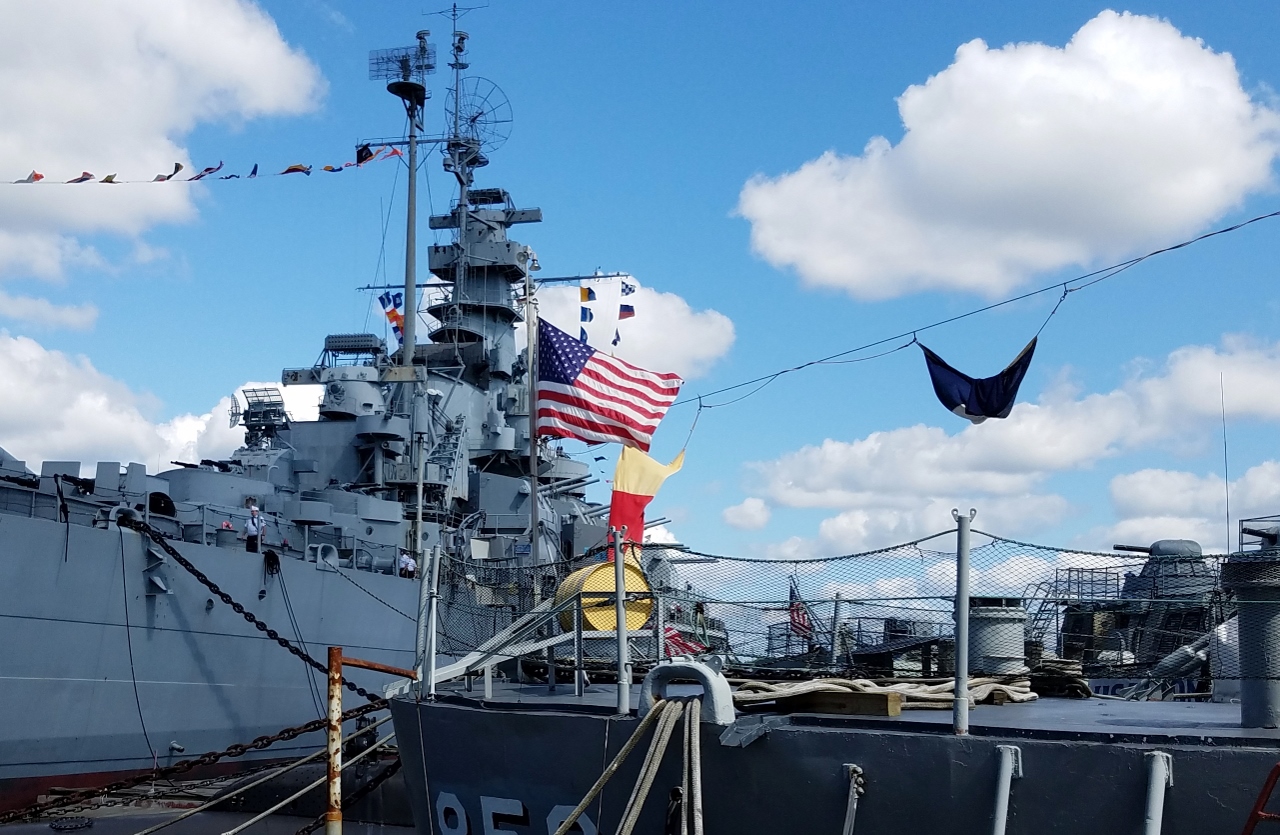
While this was going on, seven French destroyers had managed to slip out of the harbor in a bid to attack the nearby invasion beaches, so after disabling Jean Bart the Massachusetts gave chase. The shore battery at El Hank which had initially fired on the Massachusetts continued engage, scoring two 7.6 inch shell hits which caused superficial damage (some of the splinter scars from one of these hits can still be seen aboard the preserved museum ship today). In the running battle which followed, Massachusetts and the cruiser Tuscaloosa sank the destroyer Fougeaux, and the Massachusetts also shut down the destroyer Le Milan with a single 16 inch shell. In addition, the light cruiser Primaguet was forced to retire after multiple hits from the Massachusetts and cruisers Augusta and Brooklyn. By the end of the battle, the Massachusetts had fired 786 of the 800 main battery 16 inch shells she had aboard. Thus Massachusetts began her service career performing the traditional ship-on-ship combat for which the big-gun battleship had been designed. The North African campaign was, however, the last time Big Mamie would see such action. Time and technology were overtaking the battleship, and by the time she reported for service in the South Pacific in 1943 her duties had changed to a supporting role behind the new stars of the navy, the aircraft carriers. Not needed for ship-on-ship combat any more, her considerable arsenal would henceforth be used for the less glamorous duties of convoy and carrier battle group escort, and shore bombardment.
After escorting convoys and supporting air operations in the Solomons, Massachusetts sailed with an aircraft carrier group striking targets in the Gilbert Islands. Her big guns contributed to the bombardments of the Japanese-held islands of Nauru and Kwajalein, and Massachusetts also provided anti-aircraft defense for carrier groups striking the Marianas as well as supporting invasions of the Caroline Islands, Hollandia, and Ponape Island.
Following a refit, Massachusetts joined the mighty Task Force 38, supporting amphibious landings in the Philippines and air battles around Leyte Gulf, Okinawa, and Taiwan. On December 17, 1944 Task Force 38 was hit by the 140 mph winds of Typhoon Cobra in the Philippine Sea, which cost the fleet three destroyers and nearly 800 lives. Massachusetts was luckier, losing only two of her three scout aircraft to the tempest. For the remainder of the Pacific War Massachusetts continued escorting the carriers, with occasional shore bombardments as well including the islands of Iwo Jima, Okinawa, and Minamidaitō. As the war wound down, Massachusetts escorted carriers attacking Tokyo and other targets on the Japanese mainland, then closed in herself to hit shore targets with direct gunfire. These included Kamaishi and Hamamatsu in July 1945. In a repeat strike on the iron and steel center at Kamaishi on 9 August, the Massachusetts fired the last 16 inch shells of the Second World War.
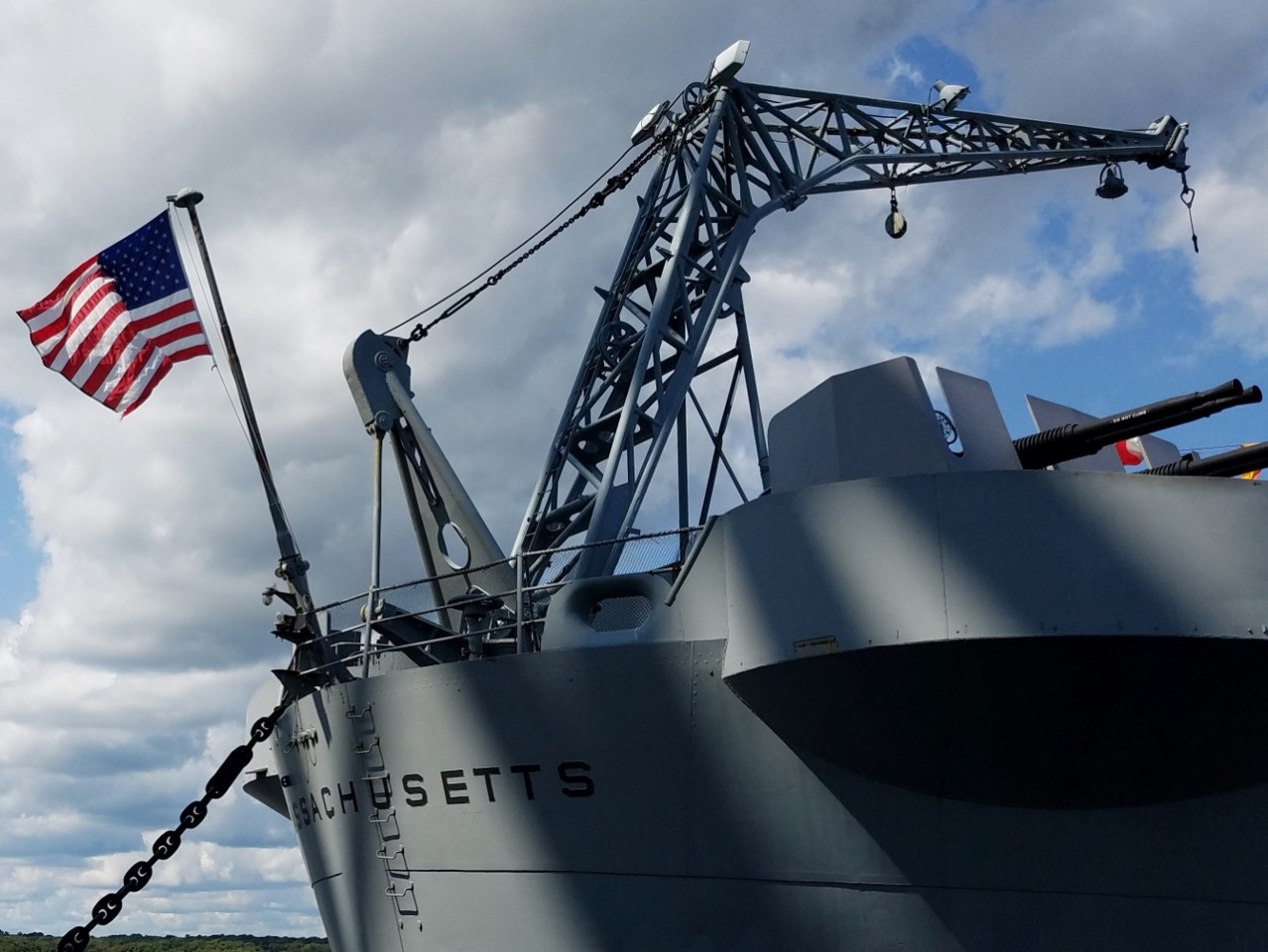
After the war, despite having been in service less than five years and being among the most modern battleships afloat, Massachusetts was decommissioned and mothballed. By 1965 she was scheduled to be scrapped, but the ship was saved when Big Mamie veterans, along with schoolchildren of the Commonwealth of Massachusetts, raised the then amazing sum of $50,000 for her preservation. The ship was converted to a floating museum and is today the star attraction of “Battleship Cove” in Fall River, Massachusetts, where she remains open to the public.
THE KIT
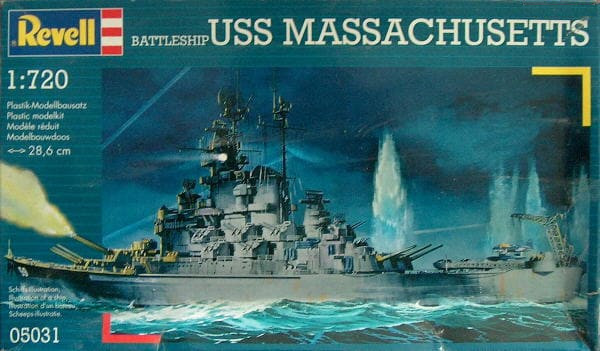
Revell’s little Massachusetts kit goes back to 1968, released as part of their 1/720 scale “International Series” ship kits. These models were pretty good for the time, inexpensive with simple construction and lots of busy surface detailing, great for younger modelers. I remember going to the dime store as a kid and being wowed by that wonderful Revell box art, studying each kit in turn to decide which one to spend my precious lawn mowing money on first. The Massachusetts, Alabama, Arizona, Pennsylvania, even Prinz Eugen (gotta have at least one bad guy, right?) all called to me, but with fire-belching 16 inch guns, enemy shell splashes close aboard and those cool looking Kingfisher seaplanes perched on the fantail… I just had to go for the Massachusetts!
Many years later, a visit to the USS Massachusetts at the Battleship Cove museum in Fall River inspired me to build another model of the Big Mamie. Logical choices for a small scale kit might have been Hasegawa’s 1/700 scale waterline South Dakota, which is a pretty good model, or Trumpeter’s 1/700 Massachusetts which is even better, but I decided to go with my old favorite instead. I was drawn to Revell’s 1/720 Massachusetts partly because it was an inexpensive full-hull model, but what really appealed to me was the prospect of experiencing again that fondly remembered kit from my childhood. Much as I loved this kit as a kid, revisiting Revell Germany’s reissue as an adult I was, well… less impressed. All that detailing that had so delighted me back then, while making the decks suitably busy, I now found mostly unconvincing. The deck planking is ok, but other molded in details come up short. The years of plastic modeling experience since I last built the kit now made me abhor the thick, solid deck edge rails enclosing the second deck, and those silly Aztec temple style stairs no longer seemed realistic at all. Worse, the focal points of any battleship model, the guns, I now realized are the weak points of the kit. Especially bad are the 20mm guns molded directly to the decks, and the deck splinter shields around the 20mm and 40mm mounts are both too thick and too short. Many are incorrectly positioned for Massachusetts anyway, since the layout of the kit is actually that of her slightly different sistership Alabama. The 40mm quads are simplified and undersized, the 5 inch duals are too squat, and those comically spindly barrels and misshapen molded-in rafts on the16 inch turrets are just sad. Vaguely molded masts, solid molded radars, solid funnel cap, incorrectly shaped and positioned platforms… the list goes on. Still, modeling challenges like these are what makes the hobby fun, right?
Comments
Tim,
Great build review and fantastic work again, as usual. You've got the touch. Happy New Year.
John
DEC 29, 2017 - 10:35 AM
Always impressive to see you turn these "borderline" kits into silk purses Tim! Beautiful work as usual!
DEC 29, 2017 - 05:25 PM
Tim,
Just love what you do with these older kits...amazing!
Cheers,
Joe
DEC 30, 2017 - 02:27 AM
Boy, I remember buying this kit way back when! Seems like my kit was molded in a dark O.D. green color, not grey. In your picture, your ship looks a lot longer than 11 inches! Fantastic looking build.
JAN 05, 2018 - 08:03 AM
Copyright ©2021 by Tim Reynaga. _OPINIONS Model Shipwrights, KitMaker Network, or Silver Star Enterrpises. Images also by copyright holder unless otherwise noted. Opinions expressed are those of the author(s) and not necessarily those of Model Shipwrights. All rights reserved. Originally published on: 2017-12-29 14:31:57. Unique Reads: 9173




